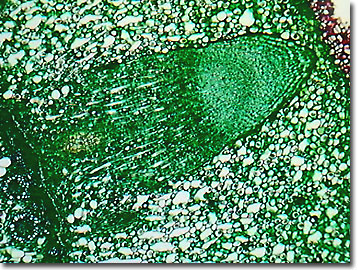Brightfield Digital Image Gallery
Acorn (Quercus) Stem Thin Section
From the tiny acorn grows the mighty oak and the acorn stem is the link that holds the two together until the fall ripening. The acorn cap with stem intact provides budding tree taxonomists with important clues to the true species identity of its source within the oak family.

View a medium magnification image of the acorn stem.
View a high magnification image of the acorn stem.
Classified as a nut, because of its bony pericarp, the acorn is actually the fruit of the oak tree. Particular to the genus Quercus, the stem broadens to the cupule or cap that holds the oak seed and fruit in place. The burr oak, Q. macrocarpa, so named because of its characteristic large seeds or acorns, was known as u'tahu can in the Native American tongue of the Lakota people, meaning acorn stem tree. More than half of the one-inch acorn is enclosed in a fringed cupule. Valued as an important diet item with great storage capability and mobility, Native Americans made acorns much more palatable by first blanching the oak nuts with wood ashes to remove a bitter taste associated with tannins.
Wildlife, including turkeys, blue jays, squirrels, and deer, utilize acorns as a food source that is rich in carbohydrates and fats. Cached acorns for future feedings are often forgotten and may germinate into new oak trees. Acorns and oak trees have long been part of superstition and religions, such as the Druids of the ancient British Isles. It was believed that an acorn should be carried to bring luck to the bearer and ensure a longer life. Others believed that placing an acorn at the window would ward off lightning.
Some acorns, such as those of the swamp white oak (Q. bicolor), found in the Ozarks and northern Missouri, are usually carried in pairs, characterized by a relatively long stem that is 2.5 inches long, and a scaly cup that is covered with fine, wooly "hair". Other varieties, such as the fruit of the black oak (Q. velutina), require two growing seasons to ripen, and then bear kernels that are extremely bitter. No matter what reproductive strategy has evolved for a particular oak species, the stem of the acorn must balance the task of supporting the heavy nut, coupled to a breaking tolerance that facilitates the success of nut gatherers and unsuspecting oak tree dispersers (such as squirrels and blue jays).
Contributing Authors
Cynthia D. Kelly, Thomas J. Fellers and Michael W. Davidson - National High Magnetic Field Laboratory, 1800 East Paul Dirac Dr., The Florida State University, Tallahassee, Florida, 32310.
BACK TO THE BRIGHTFIELD IMAGE GALLERY
BACK TO THE DIGITAL IMAGE GALLERIES
Questions or comments? Send us an email.
© 1995-2025 by Michael W. Davidson and The Florida State University. All Rights Reserved. No images, graphics, software, scripts, or applets may be reproduced or used in any manner without permission from the copyright holders. Use of this website means you agree to all of the Legal Terms and Conditions set forth by the owners.
This website is maintained by our
Graphics & Web Programming Team
in collaboration with Optical Microscopy at the
National High Magnetic Field Laboratory.
Last Modification Friday, Nov 13, 2015 at 01:19 PM
Access Count Since September 17, 2002: 19239
Visit the website of our partner in introductory microscopy education:
|
|
